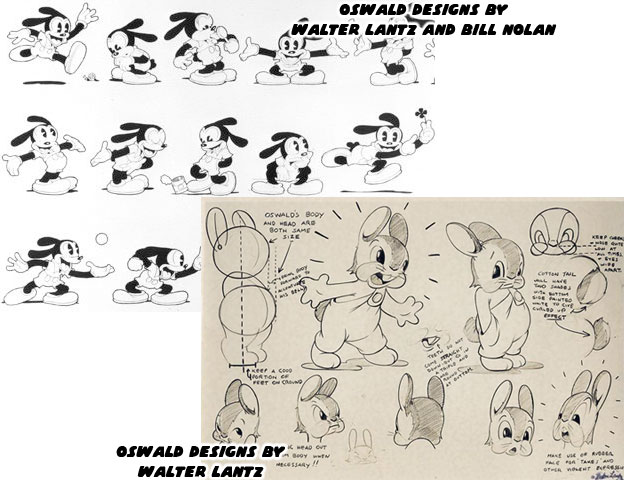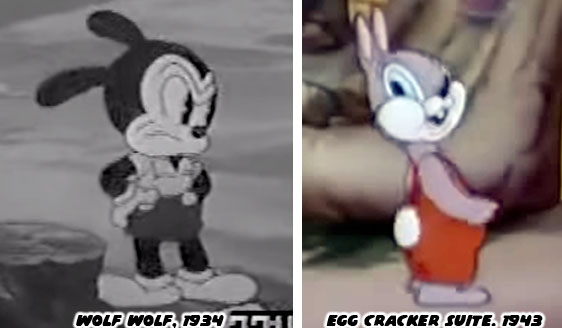It is rare for a character to maintain their original design. Whether we are talking about a comic book or a cartoon there are very few characters that have stayed visually consistent. It is possible that Otto Messmer's Felix the Cat is the one that has undergone the fewest changes since his debut in 1919. Almost every cartoon character in the Disney library has had a visual makeover through the years. Some were subtle, a change in wardrobe or voice, others were a bit more radical. The same could be said for those characters from MGM, Universal and Warner Bros. Of all the cartoon characters that ever was none changed as much as Oswald.

Within the span of a few years the character went from silent movie star to talking anthropomorphic rabbit. His look was radically different from year to year. The confusion this created may have cost him fans along the way. Even the studios producing the films sometimes couldn't find consistency on the posters they created.
The seeds for a radical makeover were planted around 1935. Up until then the changes in Oswald had been subtle. Over the span of five years he was given shoes, a shirt and even a voice. His head changed shape and his pie-eyes became widened with eyebrows added for emphasis. This look was consistent in the films and comic strips featuring the character.
The first strips were published by DC, making the Lucky Rabbit one of their first star characters. This was a decade before Superman or Batman had been created! Yet something happened in 1936, Lantz was trying his hand at producing the comic strips and submitted a few samples that were never published. The look of Oswald had changed drastically. He suddenly looked more like a traditional rabbit. His shorts were gone and replaced by overalls. It was a mix of something new and a nod to the early wardrobe created by Ub Iwerks. The rare scans are courtesy of
James Halperin . Contrary to what some people think Walter Lantz and Walt Disney held no ill will for each other. They were in fact good friends. Disney trusted that Lantz and Carl Lammle would treat the Oswald with respect so long as Universal held onto the rights. It was Charles Mintz and his dealings that Disney did not care for.
Walter Lantz wouldn't actually get the rights to Oswald until 1940 but he was still in charge of the character before then. Universal trusted his direction and his team. Mintz was seen at failing to recreate the success of Disney after stealing his character and staff. Universal fired Mintz once they realized that Oswald and / or Mickey Mouse could have been theirs if only the partnership were handled differently. Lantz in turn would run with Oswald for decades, yet couldn't quite manage to recreate the level of success that Mickey Mouse enjoyed no matter how hard he tried.

Rather than follow the mouse Lantz eventually decided to give the rabbit a makeover. The previous redesigns were co-created by Bill Nolan but the comic strip and animated makeover were owed mainly to Lantz. Oswald was a rarely seen in animation past the mid-1930s. He didn't really appear in any prominent short until the color musical Egg Cracker Suite in 1943. It was a rift on the Disney Silly Symphonies and was the last time Oswald would get a starring role. Oswald never really quite recaptured his star power. Not in animation nor in comic books. It didn't stop Lantz from directing. In fact it probably spurred him to create his own library of characters. Some of which would eventually prove to be more popular than Oswald.

Andy Panda debuted in 1939. The young panda bear was naive but quite lovable. A year later Woody Woodpecker debuted and the true star of the Lantz films was born. Others would join him as well, Wally Walrus (1944), Buzz Buzzard (1948) and Chilly Willy (1953) just to name a few. These characters helped carry the Lantz studios on throughout the years. Oswald lingered in the background for a long time. His stint in comics lasted until the late '50s but was left to reprints in foreign markets for the rest of the 20th century. It wasn't until the new millennium that Oswald would be reintroduced to audiences. Find out how this happened in the next blog.
If you would like to sponsor me
please visit my Patreon page and consider donating each month, even as little as $1 would help make better blogs and even podcasts! 





No comments:
Post a Comment